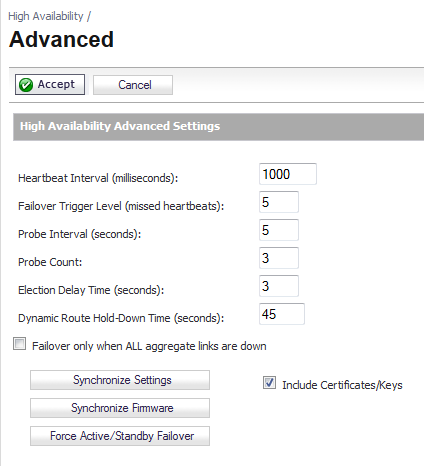
The configuration tasks on the High Availability > Advanced page are performed on the Primary unit and then are automatically synchronized to the Secondary.
|
1
|
Navigate to High Availability > Advanced.
|
|
2
|
The Heartbeat Interval timer controls how often the two units communicate. Specify the interval, in milliseconds, in the Heartbeat Interval (milliseconds) field. The minimum interval is 1000 milliseconds, the maximum is 300000, and the default is 1000.
|
|
NOTE: The Heartbeat Interval timer works in conjunction with the Failover Trigger Level timer. For example, if you set the Failover Trigger Level to 5 and the Heartbeat Interval to 1000 milliseconds, it will take 50 seconds without a heartbeat before a failover is triggered.
|
|
3
|
The Failover Trigger Level timer specifies the number of heartbeats the SonicWall will miss before failing over. Specify the number of heartbeats in the Failover Trigger Level (missed heartbeats) field. The minimum number is 4, the maximum is 99, and the default is 5.
|
This timer is linked to the Heartbeat Interval.
|
4
|
The Probe Interval is the time between probes sent to specified IP addresses to ensure the network critical path is reachable. The Probe Interval is used in logical monitoring. Specify the interval, in seconds, in the Probe Interval (seconds) field. The minimum time is 5 seconds, the maximum is 255, and the default is 20.
|
You can set the Probe IP Address(es) on the High Availability > Monitoring page. See High Availability > Monitoring.
|
5
|
The Probe Count is the number of consecutive probes before SonicOS concludes that the network critical path is unavailable or the probe target is unreachable. The Probe Count is used in logical monitoring. Specify the count in the Probe Count field. The minimum number is 3, the maximum is 10, and the default is 3.
|
|
6
|
The Election Delay Time timer can be used to specify an amount of time the SonicWall will wait to consider an interface up and stable. The Election Delay Time timer is useful when dealing with switch ports that have a spanning-tree delay set. Specify the time, in seconds, in the Election Delay Time (seconds) field. The minimum time is 3 seconds, the maximum is 255, and the default is 3.
|
|
7
|
When a failover occurs, the Route Hold-Down Time is the number of seconds the newly-active appliance keeps the dynamic routes it had previously learned in its route table. Specify the time, in seconds, in the Dynamic Route Hold-Down Time (seconds) field. The minimum time is 0 seconds, the maximum is 1200, and the default is 45. In large or complex networks, a larger value may improve network stability during a failover.
|
This setting is used when a failover occurs on a High Availability pair that is using either RIP or OSPF dynamic routing. When a failover occurs, Dynamic Route Hold-Down Time is the number of seconds the newly-Active appliance keeps the dynamic routes it had previously learned in its route table. During this time, the newly Active appliance relearns the dynamic routes in the network. When the Dynamic Route Hold-Down Time duration expires, SonicOS deletes the old routes and implements the new routes it has learned from RIP or OSPF.
|
NOTE: The Dynamic Route Hold-Down Time setting is displayed only when the Advanced Routing option is selected on the Network > Routing page.
|
|
8
|
Select Include Certificates/Keys to have the appliances synchronize all Certificates, CRLs, and associated settings (such as CRL auto-import URLs and OCSP settings) are synchronized between the Primary and Secondary units. By default, this option is enabled.
|
|
9
|
You do not need to click Synchronize Settings at this time because all settings will be automatically synchronized to the Standby unit when you click Accept after completing HA configuration. To synchronize all settings on the Active unit to the Standby unit immediately, click Synchronize Settings. The Standby unit will reboot.
|
|
10
|
To have the appliances synchronize all certificates and keys, select Include Certificate/Keys. By default, this option is enabled.
|
|
11
|
Click Synchronize Firmware if you previously uploaded new firmware to your Primary unit while the Secondary unit was offline and it is now online and ready to upgrade to the new firmware. Synchronize Firmware is typically used after taking your Secondary appliance offline while you test a new firmware version on the Primary unit before upgrading both units to it.
|
|
12
|
To force Active/Standby Failover, click Force Active/Standby Failover. This option attempts an Active/Standby HA failover to the secondary unit. Use this action to test the HA failover functionality is working properly.
|
|
13
|
When finished with all High Availability configuration, click Accept. All settings will be synchronized to the Standby unit automatically.
|
If you enabled Active/Active DPI, the Network > Interfaces page will show that the selected interface for HA Data Interface now belongs to the HA Data-Link zone.